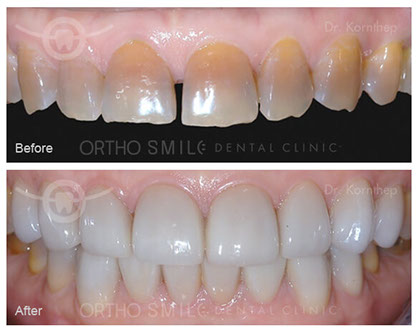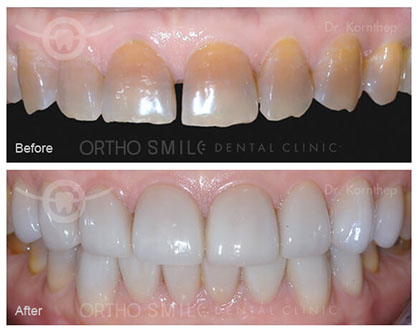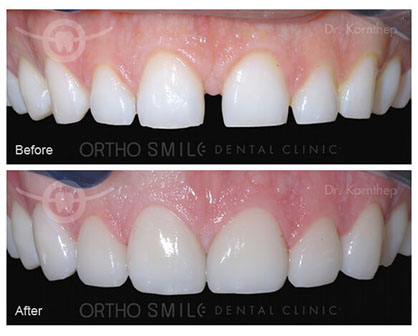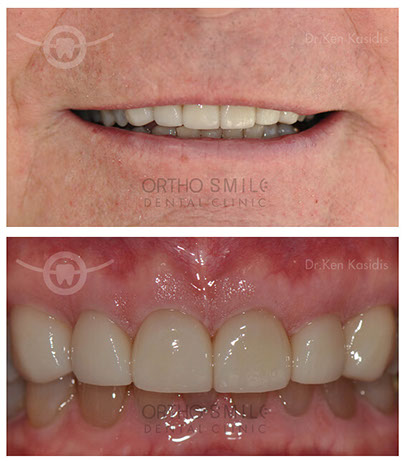
Veneers
What are dental veneers?
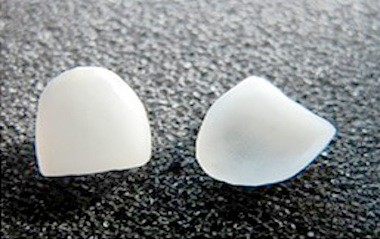
Dental veneers are thin, custom-made shells made of tooth-colored materials that are placed over the front surface of teeth. They are designed to enhance the appearance of teeth and provide protection against oral health issues. Veneers are a versatile treatment option used to address various concerns, such as repairing tooth damage, improving the shade of stained teeth, and correcting misshapen teeth.
Veneers are typically applied to the most visible teeth, such as incisors and canines, to achieve a desirable aesthetic outcome. Dentists may utilize two primary materials for dental veneers: porcelain and resin composite. Both materials offer their unique benefits and can be selected based on individual needs and preferences.
Porcelain Veneers
Porcelain veneers are ultra-thin ceramic shells that are securely bonded to the front and top surfaces of your teeth, providing an exceptional solution for enhancing your smile. Their popularity has surged due to their versatility and ease of application. With veneers, you no longer need to tolerate gaps between your teeth, stains, irregular shapes, or misalignment. By placing customized veneers on your teeth, these imperfections can be corrected swiftly and effectively, allowing you to achieve a stunning smile.
At Dental Design Center, we utilize three types of premium porcelain systems: Empress, Emax, and Feldspathic Porcelain. These renowned systems are considered the pinnacle of porcelain technology in the field of cosmetic dentistry. Our team of cosmetic dentists will carefully assess your specific needs and guide you in selecting the most suitable porcelain system for your unique case, ensuring optimal results and a dazzling smile.
Composite Veneers

Composite veneers are made of a resin composite material. They offer similar benefits to porcelain veneers, such as improving the appearance of teeth, providing a desired shade, enhancing shape, and protecting oral health. The application process for composite veneers is less invasive. In some cases, the dentist may not need to remove any enamel, making the results potentially reversible. However, composite veneers are not as durable as porcelain veneers. They typically last between five to ten years and require more maintenance compared to porcelain veneers.
Will They Look Like Normal Teeth?
Once securely bonded to your teeth, the ultra-thin porcelain veneers are remarkably discreet and remarkably resistant to staining from substances like coffee, tea, or cigarette smoke. Their strength and aesthetic appeal make them unmatched by other restorative options, closely resembling the appearance of healthy, white tooth enamel. Due to their thinness, they allow light to pass through, seamlessly adopting the natural color of your underlying teeth.
With proper care, porcelain veneers can illuminate your smile for well over a decade. At Dental Design Center, we prioritize the use of the highest quality porcelains in crafting your veneers. Furthermore, we employ advanced and proven bonding materials to ensure their long-lasting durability. Rest assured that our commitment to quality will help your porcelain veneers maintain their radiance and beauty for years to come.
VENEERS VS CROWNS
Veneers and crowns are two different types of dental restorations that serve distinct purposes and have unique characteristics. Here’s a comparison between veneers and crowns:
Veneers:
- Veneers are thin shells, typically made of porcelain or composite resin, that are bonded to the front surface of teeth.
- They are mainly used for cosmetic purposes, enhancing the appearance of teeth that are discolored, chipped, misaligned, or have gaps.
- Veneers require minimal alteration of the natural tooth structure, with only a small amount of enamel removal in most cases.
- Custom-made to match the color, shape, and size of your natural teeth, veneers create a seamless and natural-looking smile.
- Veneers are a conservative option, providing cosmetic enhancements without significantly altering the underlying tooth structure.
- They are suitable for patients with relatively healthy teeth and minor cosmetic concerns.
Crowns:
- Dental crowns, also known as caps, are prosthetic restorations that cover the entire tooth structure above the gumline.
- Crowns serve both functional and cosmetic purposes, restoring severely damaged, decayed, or weakened teeth.
- Unlike veneers, crowns require more significant preparation of the tooth structure, involving the removal of a larger portion of enamel and tooth structure.
- Crowns can be made from various materials, including porcelain-fused-to-metal, all-ceramic, or metal alloys, depending on the specific requirements.
- They provide strength, protection, and support to compromised teeth, restoring their functionality and appearance.
- Crowns are typically recommended for teeth with extensive damage, root canal-treated teeth, or teeth with large fillings that require additional structural reinforcement.
In summary, veneers are primarily cosmetic enhancements used to improve the appearance of teeth, while crowns serve both functional and cosmetic purposes to restore and protect severely damaged teeth. The choice between veneers and crowns depends on the specific condition of your teeth, the desired outcome, and the recommendations of your dentist.
The Procedure
This procedure will require three appointments:

1. Diagnosis and treatment planning
You will want to take an active role in planning your smile design. We will review the corrective limitations of this procedure and help you plan your new smile.
2. Preparation
The second appointment will take one to two hours. Although the porcelain veneer is very thin, the teeth are lightly buffed to allow for the added thickness. Approximately one half of a millimeter of tooth is removed. This may require little or no local anesthesia.
Then a mold is taken of the teeth and sent to the lab for fabrication. In some cases, temporary veneer will be placed at this time. The permanent veneer should be ready in approximately one to two weeks.
3. Bonding
At the time of your third appointment, We will first place the veneer on your teeth with water or glycerin to check the fit and color. At this point, the color of the veneer can still be adjusted by the shade of the cement used to adhere it. Once the color is determined and the veneer is ready to be applied, the tooth is cleaned with specific chemicals to achieve a bond. Special cement is placed between the teeth and the veneer and a visible light beam is used to harden the cement. This appointment takes approximately one to two hours.
Care & Follow-Up
Dental care for veneers is no different from regular dental care. Clean and floss your new smile daily, visit us regularly for professional care and maintenance, and consider wearing a night-guard to prevent teeth grinding while you sleep. If you’re ready for a smile that can boost your self-confidence and enhance your image.
Maintenance Of Your New Veneers
Maintain your regular brushing and flossing routine, without fear of damaging your veneers. We recommend using non-abrasive toothpaste for optimal care. By adhering to a diligent home care regimen, you can ensure the long-term aesthetic success of your veneers.
It is normal to experience some sensitivity to hot and cold temperatures following the placement of your veneers. This sensitivity is typically due to the minimal enamel remaining on the prepared tooth. Rest assured that this sensitivity should diminish within one to two weeks. If sensitivity persists beyond this timeframe, we encourage you to contact our office for further assistance.
If you have a history of clenching or grinding your teeth (bruxism), please inform us. We may recommend the use of a soft nightguard to alleviate stress on your teeth during sleep, minimizing potential damage.
We sincerely hope that your new veneers fulfill your aesthetic goals. With proper at-home care and regular dental visits, they are poised to provide you with a beautiful smile for years to come. Feel free to inquire about porcelain veneers today and discover how they can transform your smile!
How can I keep my veneers in good condition?
- Practice good oral hygiene: Brush your teeth at least twice a day and floss daily to remove plaque and prevent dental issues. Use a soft-bristle toothbrush and non-abrasive toothpaste to avoid scratching the veneers.
- Avoid excessive force and pressure: Refrain from biting on hard objects like ice, pens, or fingernails, as this can potentially damage or dislodge the veneers. Be cautious when consuming hard or sticky foods that may put excessive pressure on the veneers.
- Address teeth grinding (bruxism): Inform your dentist if you have a habit of grinding or clenching your teeth. They may recommend a custom-fitted night guard to protect your veneers and natural teeth from the damaging effects of bruxism.
- Follow dentist’s instructions: Your dentist will provide specific care instructions tailored to your veneers. Follow their guidance regarding oral care routines, recommended follow-up appointments, and any additional recommendations they provide.
Veneers case gallery
Empress Esthetic
Now you can see that porcelain dental veneers are a wonderful way to brighten, straighten with natural-looking results. Contact us Dental Design Center for more information about dental veneers.

